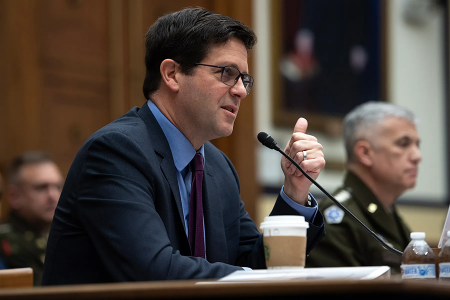“For 50 years, the Arms Control Association has educated citizens around the world to help create broad support for U.S.-led arms control and nonproliferation achievements.”
Pentagon Confronts Modernization Costs, Delays
May 2024
By Xiaodon Liang
The Defense Department is planning programmatic and posture adjustments so that it can afford the proposed $440 billion nuclear acquisition bill and accommodate delays in two of the three legs of the triad, senior officials said.

Speaking to reporters at an April 5 media roundtable, John Plumb, assistant secretary of defense for space policy, said the Pentagon is examining force posture changes “that don’t break the bank.” The military is not considering a life extension program for the Minuteman III intercontinental ballistic missile (ICBM), but rather how to manage the transition to its successor, the Sentinel ICBM, he said.
The Sentinel program, which has a $117 billion acquisition price tag, according to the latest Air Force budget request, triggered a critical breach of the Nunn-McCurdy Act in January when officials disclosed a 37 percent cost overrun. (See ACT, March 2024.) To continue the program, Defense Secretary Lloyd Austin must certify an updated cost estimate and attest to the Sentinel’s necessity later this summer. The act also requires Austin to confirm that the ICBM is a higher priority than other programs that will be cut to pay for the cost increases.
In testimony April 9 to the Senate Appropriations defense subcommittee, Air Force Chief of Staff Gen. David Allvin said the service is “actively supporting the process triggered by the Nunn-McCurdy breach” and that he expects a decision in July.
Speaking at an aerospace industry event the same day, Air Force Lt. Gen. Richard Moore, the deputy chief of staff for plans and programs, indicated that the service’s next-generation tanker and airlifter programs likely will be postponed until after the nuclear modernization program is fully funded. The commander of U.S. Transportation Command, Air Force Gen. Jacqueline Van Ovost, told the House Armed Services Committee on April 11 that the air refueling fleet could be the “most stressed fleet” under wartime conditions. Emphasizing the need for a next-generation recapitalization program, Van Ovost noted that the KC-135 aircraft, which make up most of the Air Force’s tankers, are on average 67 years old.
Separately, the Navy confirmed on April 2 that construction of the first Columbia-class ballistic missile submarine was 12 to 16 months behind schedule and would likely miss its 2027 delivery target. The disclosure was included in a review of ship construction requested by Navy Secretary Carlos Del Toro in January. Speaking on April 10 before the House Appropriations defense subcommittee, Del Toro blamed the delays on late delivery of the submarine’s turbine generator by contractor Northrop Grumman, as well as recruitment and retention problems at the shipyards. But USNI News reported on April 10 that slow completion of the bow dome of the submarine also has contributed to delays.
Del Toro said during testimony before the Senate Appropriations Committee’s defense subcommittee on April 16 that the Navy is studying whether Ohio-class submarines can serve additional deployments past their intended retirement date. The secretary disclosed that five Ohio-class boats have already been identified as safe for at least one additional patrol at sea.
The Navy’s other submarine construction effort, the Virginia-class attack submarine program, is three years behind schedule, according to the review. Service officials attributed this extended delay to prioritization of the Columbia-class submarine.
Air Force Secretary Frank Kendall said during April 9 testimony before the Senate Appropriations defense subcommittee that the unit cost of the B-21 bomber, another major component of the nuclear triad modernization effort, was lower than previously expected due to successful price negotiations with contractors.
The Air Force, in its budget for fiscal year 2025, lowered its annual procurement request for the B-21 to $2.7 billion from a projection of $3.9 billion in fiscal 2024.
Because the B-21 program does not disclose the number of bombers purchased in each year, it is not possible to verify if the reduction is due solely to unit cost savings or also a decrease in the number of planes on order.
A U.S. Air Force representative told Bloomberg News that the lower request reflected “no material reductions in program quantities or scope.”
